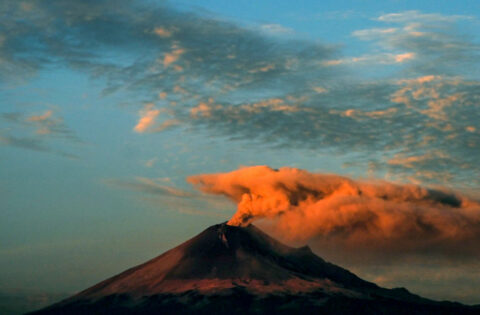There’s some eye-opening volcanism happening on Earth — in Iceland, Italy, Mexico, and beyond.
It might appear, especially perusing the internet or social media, that there’s an unusual number of volcanoes erupting, or an increase in global volcanic activity. But, unfortunately for the sensationalists and doomers, there’s not.
Earth is a volcanic world. Some 40 to 50 volcanoes are erupting on any given day, says the Smithsonian Institution’s Global Volcanism Program, which tracks eruptions around the world. As of October 2023 (the most recent update), the program noted 46 volcanoes were erupting. So the ongoing activity is absolutely normal.
What’s more, each year since 1991, between 56 to 88 volcanoes have erupted on our planet. And in the last 12,000 years, some 1,350 volcanoes have been active. Eruptions aren’t just normal — they’re responsible for shaping Earth as we know it. “More than 80 percent of the Earth’s surface — above and below sea level — is of volcanic origin,” the U.S. Geological Survey explains. “Gaseous emissions from volcanic vents over hundreds of millions of years formed the Earth’s earliest oceans and atmosphere, which supplied the ingredients vital to evolve and sustain life.”
Yet some of the violence associated with eruptions — earthquakes, explosions, and fissures opening up in the ground — can indeed be unsettling. As Iceland prepares for a significant eruption, the town of Grindavík, a little over an hour’s drive from the capital, has been evacuated. Large steaming cracks have opened in the streets. Paired with recent eruption footage on other continents, it might appear something is geologically afoot. But as further described below, this isn’t the case.
Is volcanic activity increasing?
In the modern day, we might notice or observe more volcanoes erupting, but that doesn’t mean activity is increasing.
“The Global Volcanism Program does not see any evidence that volcanic activity is actually increasing,” the organization writes.
Over the last couple centuries, as populations expanded and observations increased, the number of active volcanoes per year has accordingly gone up, as the graph below shows. “At first glance the nearly exponential increase through recent centuries suggests that the planet may soon be overwhelmed by volcanic activity, but this increase tracks the striking growth of global population (dashed line on figure 1) that has spread potential observers of eruptions over much of the Earth and the technological advances that have facilitated reporting of those eruptions,” the Global Volcanism Program explains.

As population has increased, the number of observed and known volcanoes and eruptions has increased.
Credit: Global Volcanism Program

An ash cloud from Popocatépetl volcano in Mexico in 2023.
Credit: Alfredo Estrella / AFP / Getty Images
A notable spike in observed volcanic activity in the late 1990s is attributable to advances in satellite observation and other reporting networks, whose observations have since been amplified by the widely expanding internet. For example, NASA‘s Earth Observing System Terra satellite came online in 1999. “Its MODIS infrared sensors have detected volcanic eruptions in sparsely populated or rarely visited regions,” the Global Volcanism Program notes. “These collective ‘eyes in the skies’ have detected eruptions that might otherwise go unreported.”
Want more science and tech news delivered straight to your inbox? Sign up for Mashable’s Light Speed newsletter today.
When the Hunga Volcano erupted in the South Pacific in January 2022, scientists globally were able to rapidly observe, via satellites, the dramatic event. Since then, the underwater eruption has been intensely researched. Yet a century ago, few people would have ever known it even happened.
So as you hear of global volcanic activity in the coming months and years, including from “supervolcanoes” that have a history of erupting enormous amounts of material, there’s no need to be particularly alarmed. It’s a sure bet that when you wake up tomorrow, dozens of volcanoes will be active. And the day after that, and the day after that. But for those nearby any activity, it’s wise to have a healthy respect for volcanoes, and heed any warnings from experts.
